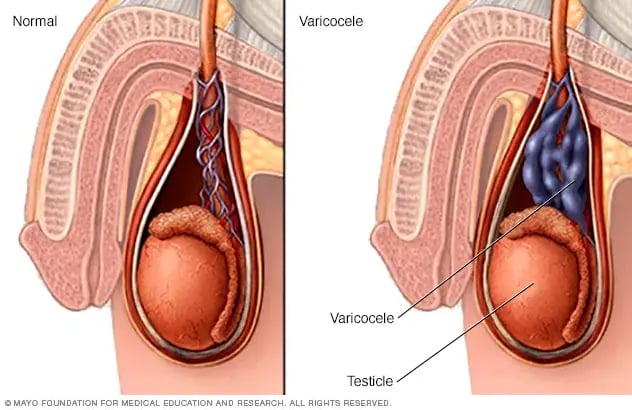When it comes to male health, especially the testicles, it can be sensitive subject. But taking the time to understand the signs and symptoms of certain conditions, such as varicoceles, can have a big impact on your quality of life and health. Being proactive is always a good thing - and with that in mind let's cover the 5 major signs and symptoms of a varicocele.
What is a Varicocele?
A varicocele is a collection of swollen veins in the scrotum. It is a common condition, occurring in about 25% of young men, and usually causes only minor symptoms. In some men, however, a varicocele is associated with more severe pain which can be troublesome and interfere with normal activities.
Varicoceles can also be associated with reduced fertility and are therefore commoner in those men suffering from fertility problems.
Varicoceles occur because of a problem with the valves in the veins which carry blood from the scrotum and testicles.
A spermatic cord, within the pampiniform plexus holds up each testicle, and this cord contains the veins, arteries and nerves that support the testicles. In healthy veins, one-way valves move the blood from the testicles back to the heart.
When leaky, these valves do not return blood back to the heart as they should and this causes a buildup of pressure and therefore swollen veins, and a varicocele develops slowly over time. They are more common on the left side of the scrotum as the left testicular vein is more prone to valve problems.
There are no established risk factors for developing a varicocele, and the exact cause is unclear.

The 5 Signs To Look For
When it comes to identifying varicoceles, start by looking for the following symptoms:
1. A Dull Ache in the Testicles - this is a common sign to watch for since you also ‘feel’ it. It’s common amongst sufferers to experience more pain later in the day, or after exercising. Some men have also describe a ‘dragging’ sensation in their testicle. In rare cases you may feel a sharp, acute pain described as a ‘stabbing’ pain.
2. A Feeling of Heaviness in the Testicles - because varicoceles are caused by poor blood flow, resulting in swollen veins, it can be common for sufferers to have a feeling of heaviness in the scrotum.
3. Visibly Swollen Veins - another symptom that is a bit easier to identify is the presence of visibly swollen veins in the scrotum, most commonly on the left side.
4. Visibly Smaller Testicle - a lack of blood flow can also cause testicular atrophy, where one side is noticeably smaller than the other. This is a different symptom to swelling but they are closely related.
5. Infertility - this is a symptom you won’t be able to immediately identify yourself, and is more useful for your doctor, but varicoceles have been shown to influence fertility.
Diagnosing a Varicocele
In many cases you won’t ever need to see a doctor unless you are experiencing pain, or believe you may be having trouble conceiving - varicoceles are often diagnosed during a fertility assessment.
In other cases, diagnosis is usually done via a physical examination by your GP or a specialist, such as an Interventional Radiologist or Urologist.
In some cases, your doctor may perform a scrotal ultrasound, which can help measure the spermatic veins and gives a more detailed, accurate, visual depiction of the condition.
Once diagnosed, your doctor will grade the varicocele with one of four grades:
Grade 0 - only detectable by an ultrasound.
Grade 1 - palpable only during Valsalva maneuver. This means that the doctor can feel your swollen veins but only when you take a deep breath and hold it while your doctor performs a physical examination.
Grade 2 - easily palpable but not visible. This means your doctor can easily feel the swollen veins, without a Valsalva maneuver, but cannot easily see them as there is no swelling or visible veins.
Grade 3 - easily visible. This means that your doctor can immediately identify a varicocele with just a visual examination.
The size doesn’t necessarily affect treatment, because you may not need treatment. How you manage varicocele depends on your pain levels or infertility issues.
How is Varicocele Treated?
One treatment option, and the one that we offer at Northern Beaches Interventional Radiology, is varicocele embolisation. Varicocele embolisation is the process of blocking blood vessels in the testicles that have caused a varicocele to develop.
A thin tube is introduced via a vein in the neck or groin and navigated to the veins inside the abdomen under x-ray guidance. Once in position special metal coils, and sometimes foam, are used to close the abnormal veins.




